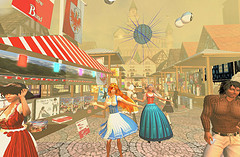Why does Linden Lab permit the conflict to arise?
Linden Lab representatives like to say, in public, that they’re not “content creators” or “community managers” — they develop the technology so that content creators and community managers can join Second Life and do their work there. However, it’s clear that Linden Lab also manages communities, and, even if they don’t develop content themselves, encourages others, under their guidance, to develop content for Linden Lab. For free.
Ironically, they’re doing all this without a clear role of “Community Manager” (although there is a “Governance Team”).
On the other side of the spectrum, I find it most amusing that a huge chunk of the “policy” decisions made for Blue Mars is by an Avatar Reality representative with the title “Community Director” — who really says that Blue Mars is just a platform, and Avatar Reality’s role is to attract game designers and developers to provide all services — they’re not in the community business at all. They want developers — their clients — to pay for the privilege to offer services to end-users. They’re not going to provide anything except technology.
Hmm. It’s curious that the most “recent” big community-related events have popped up recently, as more and more people were trying to jump into the Blue Mars bandwagon because they hoped it to be the “salvation” for the desperate residents that wanted a “more stable” world 🙂
But if we zoom out a little bit more, and see what kinds of social virtual worlds are out there, a pattern emerges. Before 2007, they all provided some kind of “community” services, with or without the users’ help. There.com, IMVU, and even Kaneva all follow the tradition, probably started with ActiveWorlds, where users not only provide services inside their worlds — for free or not — but actively collaborate, to a degree, with the company behind it. Moove also gets a lot of “community” promotion by the company behind it. Sure, I know that except for IMVU (which keeps growing and has a reasonably successful in-world economy as well), the other worlds might not be good references. But all still have this idea that part of the job of the company is to promote services for the users and foster community — a tradition that social virtual worlds inherited from MMOGs.
The “new generation” of virtual worlds that integrate user-generated content (albeit never in the same way that we SL residents employ the word — we think about collaborative, real-time user-created content, without pre-approval, and using in-world tools, not external ones) are all different. They might have “community managers” somewhere in their team. But they’re all selling technology. “Partners” or “developers” are external organisations or individuals that sign a contract or agreement and develop content with a purpose; they might also offer all kinds of services on top of the content they’ve developed. In a sense, they’re much closer to merely being a software house that released a “virtual world product” — an engine, a software application. The difference between, say, Unity or Blue Mars is that you buy a license for Unity but have to host your own MMOG/social virtual world on your own servers — while Blue Mars, Multiverse, or even Metaplace allow you to spare the costs of hosting and use their servers to provide an immersive experience for your customers.
It’s a completely different business model. As time passes, it will be harder and harder to compare them with Linden Lab’s Second Life at all.
That’s the fun bit, and one that doesn’t cease to amuse me. Second Life is, like the Internet, a complete mix of technologies, attitudes, models, and solutions, all confusingly assembled together into the same package, and not being the “best” in either case. It’s the Swiss Army Knife of virtual worlds (like, well, the Internet’s protocols became the universal networking solution, even though for specific networking solutions, far better technologies exist).
Second Life continues to refuse to become “merely a technological software platform”. It’s not “applications” — in the sense of client and server. It transcends the simplistic concept of being “merely a communications protocol”. It’s not a game, nor a game development platform. It’s not a software development tool, not a 3D modelling tool. It’s not merely a rendering engine with some features. It’s not simply a 3D chat, or even a 3D social networking tool. It has an economy, a huge economy in fact, but it’s not merely an economy. SL is one of the largest international VoIP operators in the world, but it’s not simply a “webcam chat” application, or an alternative business solution for videoconferencing or a collaborative environment. And so on… it’s not anything of the above in particular, but does all the above at the same time, and thus defies classification — specially because it continues to be unique, and this is what gets so many people angry when the “competition” fails to deliver something “just like SL” but falls always very short on expectations.
I’m now quite sure that there is no competition to Second Life and never will be. Every time I write this, or say it in public, people point out to me how certain aspects of SL are “obsolete” and that “competing products” are much better at it. That’s fine if you take isolated aspects of SL and compare them to other solutions. For instance, Skype is better at VoIP than SL. But SL is not just a 3D chat with voice. Or, say, almost every 3D game in the planet is faster than SL, or has a better way to develop combat games — but SL is not a game development platform. Or there are lots of better collaboration tools out there, many of which using 3D environments and avatars — but none have a teeming economy. There might even be better 3D environments where you can listen to live music performances online, but none allow you to buy land and have your own house. And so on.
There is nothing so complex as Second Life and never will be. This gives Linden Lab a huge responsibility. (Aren’t you happy that they’re actually a profitable company that does not require external funding or going public to continue to grow and thrive, unlike almost all of their direct competition in what we call “social virtual worlds”?) It means that there is no way to fully replicate Second Life as a whole, and if one day SL disappears, there will be nothing to replace it (except, of course, a loosely-assembled grid of interconnected OpenSim operators — but I tend to put OpenSim in the same bag as SL, actually).
So in the next few years, we will obviously continue to hear about alleged “competitors” here and there. Some will compete on community. Some will compete on content development. Some on collaboration. Some on game design. Some might even compete on the economy. A lot will be VoIP-based 3D chats with, say, faces mapped to avatars. Many might become the “3D Facebook”. Most will have cool technology and impressively looking graphics. A lot will allow programmers to cry with joy at what they can do. Many will possibly attract millions of users wishing to join a live music concert — or merely a conference about, say, artificial intelligence. Some might appeal to the corporate clients looking for alternative teleconferencing solutions. Some might target the machinima market and provide cool content creation tools that facilitate the development of 3D animations, perhaps at a professional level. Who knows what will come next! And whenever each of these “worlds” or “environments” will be announced, everybody who is just interested in a specific, single aspect of Second Life will immediately announce “the end of SL as we know it” and the “imminent exodus to World X”. Of course, they forget that only those specific residents that are interested in the limited functionality of World X will jump to it. The rest, who have different interests, will not be impressed, since none will provide everything that SL provides in the same environment, and that’ll be its greatest strength for the years to come.
Now, I don’t wonder any longer why Linden Lab so often seems to have “split personalities”. I would, too, if I had to deal with all the conflicts that such a wide variety of uses of Second Life will inevitably generate 🙂






